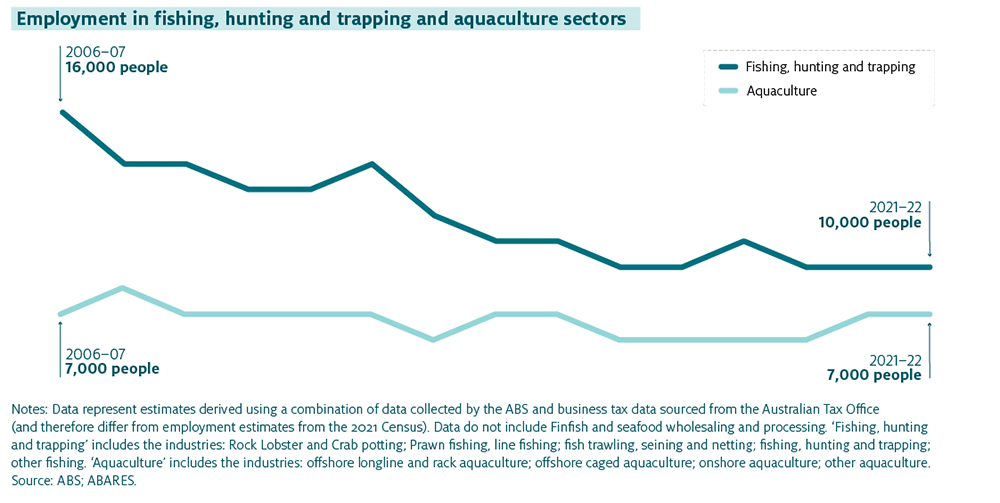Annual employment estimates
Estimates from 2021 Census
| Table 2 Estimated employment in the Australian commercial fishing and aquaculture industry, 2021 a | |||||||||
|---|---|---|---|---|---|---|---|---|---|
| Category | NSW | Vic. | Qld | SA | WA | Tas. | NT | ACT | Aust. b |
| (no.) | (no.) | (no.) | (no.) | (no.) | (no.) | (no.) | (no.) | (no.) | |
| Aquaculture | |||||||||
| Onshore aquaculture | 135 | 99 | 359 | 74 | 92 | 96 | 54 | 0 | 912 |
| Offshore longline and rack aquaculture | 627 | 17 | 106 | 254 | 174 | 911 | 139 | 0 | 2,227 |
| Offshore caged aquaculture | 122 | 27 | 69 | 70 | 9 | 978 | 0 | 0 | 1,272 |
| Aquaculture, nfd | 124 | 171 | 167 | 152 | 99 | 236 | 20 | 0 | 976 |
| Total | 1,008 | 314 | 701 | 550 | 374 | 2,221 | 213 | 0 | 5,387 |
| Fishing | |||||||||
| Rock Lobster and Crab potting | 32 | 37 | 87 | 175 | 538 | 144 | 10 | 0 | 1,018 |
| Prawn fishing | 48 | 9 | 162 | 66 | 46 | 0 | 17 | 0 | 345 |
| Line fishing | 4 | 6 | 14 | 22 | 0 | 0 | 0 | 0 | 46 |
| Fish trawling, seining and netting | 3 | 7 | 22 | 21 | 4 | 5 | 0 | 0 | 63 |
| Other fishing | 57 | 59 | 19 | 97 | 105 | 82 | 4 | 7 | 436 |
| Fishing, nfd | 738 | 288 | 735 | 464 | 414 | 192 | 92 | 4 | 2,929 |
| Total | 882 | 406 | 1,039 | 845 | 1,107 | 423 | 123 | 11 | 4,837 |
| Fishing, hunting and trapping, nfd | 28 | 21 | 24 | 18 | 14 | 3 | 7 | 0 | 109 |
| Processing and wholesaling | |||||||||
| Seafood processing | 280 | 258 | 246 | 252 | 200 | 348 | 8 | 0 | 1,586 |
| Fish and seafood wholesaling | 650 | 601 | 559 | 168 | 368 | 109 | 21 | 3 | 2,487 |
| Total | 930 | 859 | 805 | 420 | 568 | 457 | 29 | 3 | 4,073 |
| Grand total | 2,854 | 1,592 | 2,562 | 1,827 | 2,069 | 3,108 | 384 | 19 | 14,408 |
a Industries are consistent with the Australian and New Zealand Standard Industrial Classification (ANZSIC) 2006 (Trewin and Pink 2006).
b Total national employment in commercial fishing and aquaculture industries includes a small number of persons employed in external territories of Australia. As the ABS randomly adjusts some small values published in the Census of Population and Housing to avoid release of confidential data, total national employment may be different from combined state and territory employment, and total industry employment may be different from combined category employment. The ABS advises that no reliance should be put on small cells.
nfd Not further defined.


